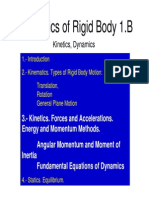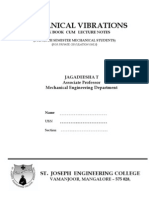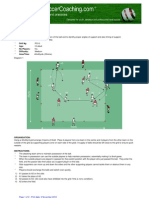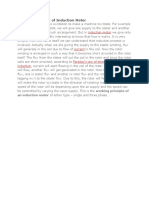Inverse Dynamics: Static Equilibrium
Uploaded by
Lucian NicolauInverse Dynamics: Static Equilibrium
Uploaded by
Lucian NicolauStatic Equilibrium
Inverse Dynamics
A system is at rest and will remain at rest No translation or rotation is occurring or will occur Conditions for static equilibrium (from Newtons 1 st Law):
Net external force in x direction equals zero Net external force in y direction Fy = 0 equals zero Net torque produced by all external forces and all external T=0 torques equals zero Can use any point as the axis of rotation Can solve for at most 3 unknown quantities
Fx = 0
Objectives: Define dynamic equilibrium Introduce the technique of inverse dynamics
Dynamic Equilibrium
Applies to rigid bodies that are accelerating Conditions for dynamic equilibrium (from Newtons 2nd Law):
Net external force in x direction equals mass times x accel. Fx = m a x Net external force in y direction Fy = m a y equals mass times y accel. Net torque produced by all external forces and torques T=I equals moment of inertia times angular accel. Net torque must be computed about center of mass or a fixed axis of rotation Can solve for at most 3 unknown quantities
General Equations of Motion
From dynamic equilibrium: m ax = Fdx Fpx m ay = Fdy Fpx W Icm = Td Tp + (L c) sin Fdx + c sin Fpx (L c) cos Fdy c cos Fpy Fdy Td
Distal joint
Fpx y c
Proximal joint
Tp
Fpy x
L = segment Fdx
length
Computing Joint Forces and Torques
It is possible to measure:
joint position (using video / motion capture system; lab 3) ground reaction forces (using force plate; lab 6) center of pressure (using force plate)
Analysis by Segment
To compute joint forces and torques, body is broken down into Fkneex individual segments Analyze from distal to leg proximal
Fankley Fanklex Tankle Tankle
Fhipx
thigh
Fkneey Tknee Tknee Fkneey
Thip Fhipy
Wthigh
Fkneex
From joint position data, can compute:
absolute angle of each body segment (lab 5) location of center of mass of each segment (lab 8)
Can use central difference method to compute:
angular velocity of segment (lab 5) angular acceleration of segment x and y velocity of segment center of mass (lab 3) x and y acceleration of segment center of mass
Wleg
Fanklex Fgrfx
Finally, use general equations of motion to compute joint forces and torques
Fankley
foot
Wfoot
Fgrfy
The End
You might also like
- Spanish Academy Soccer Coaching Passing Drill50% (2)Spanish Academy Soccer Coaching Passing Drill2 pages
- 471 - Instructions FIDY8BW9 FIDY8BW9-SHPR F1DY8G59 F1DY8G59-SHPR F1DY81G9 F1DY8009 Renew-Led-Desk-LampNo ratings yet471 - Instructions FIDY8BW9 FIDY8BW9-SHPR F1DY8G59 F1DY8G59-SHPR F1DY81G9 F1DY8009 Renew-Led-Desk-Lamp1 page
- CEDYNA20 Module 4 - Kinetics of Particles - Impulse and MomentumNo ratings yetCEDYNA20 Module 4 - Kinetics of Particles - Impulse and Momentum27 pages
- Engineering_Mechanics_Lecture_1_NoteslllNo ratings yetEngineering_Mechanics_Lecture_1_Noteslll2 pages
- Dynamics (Egr2301) - Spring 2015 Project Video Analysis and Modeling of Dynamic SystemsNo ratings yetDynamics (Egr2301) - Spring 2015 Project Video Analysis and Modeling of Dynamic Systems19 pages
- Chapter 4: Kinetics of A Particle - Work and EnergyNo ratings yetChapter 4: Kinetics of A Particle - Work and Energy130 pages
- ME-329 - Mechanical Vibrations: Dated: 10 March, 2021No ratings yetME-329 - Mechanical Vibrations: Dated: 10 March, 202111 pages
- Chapter 202 201 20Mathematical 20modeling 20of 20dynamical 20systemsNo ratings yetChapter 202 201 20Mathematical 20modeling 20of 20dynamical 20systems37 pages
- Form 4 Physics -Principle of Moments HandoutNo ratings yetForm 4 Physics -Principle of Moments Handout3 pages
- Statics and Strength of Materials Intro Beam AnalysisNo ratings yetStatics and Strength of Materials Intro Beam Analysis69 pages
- Spring and Stiffness Mass or Inertia Elements Damping Simple Harmonic Motion Free Vibrations of SDOFNo ratings yetSpring and Stiffness Mass or Inertia Elements Damping Simple Harmonic Motion Free Vibrations of SDOF16 pages
- STATICS _ Moment Of a Force - SS3 FURTHER MATHSNo ratings yetSTATICS _ Moment Of a Force - SS3 FURTHER MATHS3 pages
- Lecture 10 Review of Statics - CompleteNo ratings yetLecture 10 Review of Statics - Complete17 pages
- Physics Reviewer: Units, Quantities and VectorNo ratings yetPhysics Reviewer: Units, Quantities and Vector4 pages
- Elastic Collision in 2D: RA Adnan Müslim MenevşeNo ratings yetElastic Collision in 2D: RA Adnan Müslim Menevşe12 pages
- Subject: Dynamics Kinematics of Particles: Newton's Second LawNo ratings yetSubject: Dynamics Kinematics of Particles: Newton's Second Law11 pages
- System Requires Only One Coordinate To Describe Its Position at Any InstantNo ratings yetSystem Requires Only One Coordinate To Describe Its Position at Any Instant11 pages
- Newtonian Mechanics - Part 1: L Del Debbio, University of EdinburghNo ratings yetNewtonian Mechanics - Part 1: L Del Debbio, University of Edinburgh12 pages
- Chapter 13 Kinetics of Particle - Force & AccelerationNo ratings yetChapter 13 Kinetics of Particle - Force & Acceleration31 pages
- Student Solutions Manual to Accompany Economic Dynamics in Discrete Time, secondeditionFrom EverandStudent Solutions Manual to Accompany Economic Dynamics in Discrete Time, secondedition4.5/5 (2)
- Numbers Up Transitions With Conditioning (SSG) 2100% (1)Numbers Up Transitions With Conditioning (SSG) 22 pages
- Numbers Up Transitions With Conditioning (SSG) 2100% (1)Numbers Up Transitions With Conditioning (SSG) 22 pages
- Directional Possession With Targets (High Aerobic)No ratings yetDirectional Possession With Targets (High Aerobic)4 pages
- Combinations of Control, Turnin G and ReceivingNo ratings yetCombinations of Control, Turnin G and Receiving3 pages
- Geomechanics Applied To The Petroleum Industry100% (1)Geomechanics Applied To The Petroleum Industry180 pages
- Covalent & Metallic Bonds: Chapter 13 Section 3No ratings yetCovalent & Metallic Bonds: Chapter 13 Section 320 pages
- Inductive Proximity Sensors v8 t3 Ca08100010eNo ratings yetInductive Proximity Sensors v8 t3 Ca08100010e102 pages
- Advanced Computer Graphics Bamu University QuestionsNo ratings yetAdvanced Computer Graphics Bamu University Questions2 pages
- Important Questions Class 10 Science Chapter 12No ratings yetImportant Questions Class 10 Science Chapter 1240 pages
- QRO02 L3 Startup-SilentAire - AHU CriticalNo ratings yetQRO02 L3 Startup-SilentAire - AHU Critical9 pages
- Classification Writing and Naming of Inorganic CompoundsNo ratings yetClassification Writing and Naming of Inorganic Compounds40 pages
- Chapter-04-Applications-Thermodynamics-Earth 4744 0 PDFNo ratings yetChapter-04-Applications-Thermodynamics-Earth 4744 0 PDF43 pages
- PST MaxxShot Brochure Fina06th March EditlNo ratings yetPST MaxxShot Brochure Fina06th March Editl4 pages
- Semi Mobile Flashing Unit: Project Number 0470100100No ratings yetSemi Mobile Flashing Unit: Project Number 04701001003 pages
- Cáp IGUS CF9-EU - Data - Sheet - Chainflex - CF9No ratings yetCáp IGUS CF9-EU - Data - Sheet - Chainflex - CF910 pages
- POSTER - N.L.Tapia Falcon, M.Huanca Ccamerccoa PDFNo ratings yetPOSTER - N.L.Tapia Falcon, M.Huanca Ccamerccoa PDF1 page
- Beamex Ebook Calibration Essentials PressureNo ratings yetBeamex Ebook Calibration Essentials Pressure40 pages











































































































